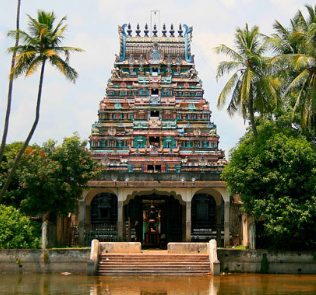The Brahmapureeswarar Temple has a rich history linked to the curse of Brahma, who was punished for lying that he had seen Lord Shiva’s thirumudi (hair). This curse impeded his creative endeavours and disrupted the functions of the Navagrahas (nine planetary deities). To atone for his actions, Brahma created a Brahma Tirtha at this temple, constructed a lingam from sand, and performed puja to rid himself of the curse. Consequently, the presiding deity of this temple became known as Brahmapureeswarar. With Brahma's penance, the Navagrahas also overcame their afflictions, leading to the name "Kolili" for this sacred place. A unique feature of this temple is that the Navagrahas are arranged in a straight line.
Sthala Puranam :
The Brahmapureeswarar Temple is one of the Saptha Vitanga Sthalams, housing one of the Maragatha Lingams that Muchukunda Chakravarti obtained after his trials with Indra. This temple is associated with the Bhringa Natanam, representing the dance of a bee hovering over flowers.
According to legend, Brahma was cursed by Lord Shiva for falsely claiming to have seen the top of the pillar of fire. As a result of this curse, he lost his role as the creator, disrupting the routine of the planets (grahas). In an attempt to seek forgiveness, Brahma dug up a sacred water body, known as the Brahma Theertham, and constructed a Lingam from sand, praying to it for pardon. His penance was successful, and the Lord was henceforth known as Brahmapureeswarar. Due to the moolavar murti being made of sand, the abhishekam (ritual bathing) is performed by covering it with a vessel called kuvalai (in Tamil), which led to the town being named Thirukuvalai. On Amavasya (new moon) days, the lingam is uniquely worshipped with sambrani deepam (benzoin).
Additionally, the Navagrahas were relieved of their doshas (afflictions) at this temple, contributing to the town's name Tirukkollili (with "Kol" in Tamil meaning planet). This temple is also recognized as a Navagraha dosha nivritti sthalam (a place to overcome the afflictions of the Navagrahas), and the Navagrahas are uniquely arranged in a line, all facing south.
Bheema, one of the Pandavas, prayed at this temple to be relieved of the Brahmahathi dosham resulting from killing Bakasuran. The sage Agastyar, along with the Pandavas and the Navagrahas, is also said to have worshipped here, and the lingam worshipped by Agastyar can be found in the prakaram (outer courtyard).
Notably, the goddess Ambal faces east in this temple, a rarity, while Vinayakar is known here as Thyaga Vinayakar.
The temple's puranam is closely intertwined with that of the nearby Sundareswarar Temple at Kundaiyur. It is said that the Lord arranged for Sundarar to receive the grains from Kundaiyur Kizhaar at Tiruvarur. This event is commemorated annually during the Sundarar Utsavam on Masi Magam.
The temple also features inscriptions dating back to the reign of Kulothunga Chola I and Sundara Pandiyan, highlighting its historical significance.
Administration History :
The temple was originally constructed as a Mada Kovil by Ko Chenkat Chozhan and later rebuilt in stone by the Chozhas before being expanded by the Pandyas and Vijayanagara Nayakas. Inscriptions from the Chola and Pandya periods record significant endowments and renovations. The temple has been under the administrative control of the Dharmapura Adheenam in modern times. It underwent a major Maha Kumbhabhishekam in 1999. The temple remains a significant religious and historical site, preserved under current management.
